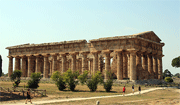And it came to pass that in the time of Augustus (27 B.C.–14 A.D.) about 320,000 citizens of Rome regularly received grain as a generous, yet traditional distribution of the civil authority. This distribution was personified in the divine Annona, pictured on coins holding a cornucopia.
The population of Rome had experienced unprecedented growth. Scholar Alain Touwaide discusses how this population boom created a shortage of many medicinal plants, traditionally grown until then in countryside orchards. In Augustus’ time, knowledge of plants from the Eastern Mediterranean area was introduced in Rome, and encouraged the planting of artfully crafted urban gardens. The gardens probably would have featured cabbage, praised by Cato the Elder as the finest of all vegetables which was known as an anti-inflammatory. But this “introduction of the countryside in the cities” as Pliny described it, wasn’t enough to respond to the medicinal plant shortage.
Touwaide makes a case that the Roman conquest of the Mediterranean area was actually an attempt to take control of the production of medicinal plants to ensure a continued supply for the ever-growing population. Both the conquest and the urban gardens were a timely and appropriate response to a growing health crisis. What practical garden-ing tips might the ancient Romans have for us?
Touwaide is the scientific director of the Institute for the Preservation of Medical Traditions.
Smithsonian Connections

Go on a cruise to explore the treasures of Italy and the Dalmatian coast from Rome to Venice.
Visit the Smithsonian Journeys page to see more
trips to Italy.
Learn more about Italian folk music, listen to clips from Smithsonian Folkways recordings>>